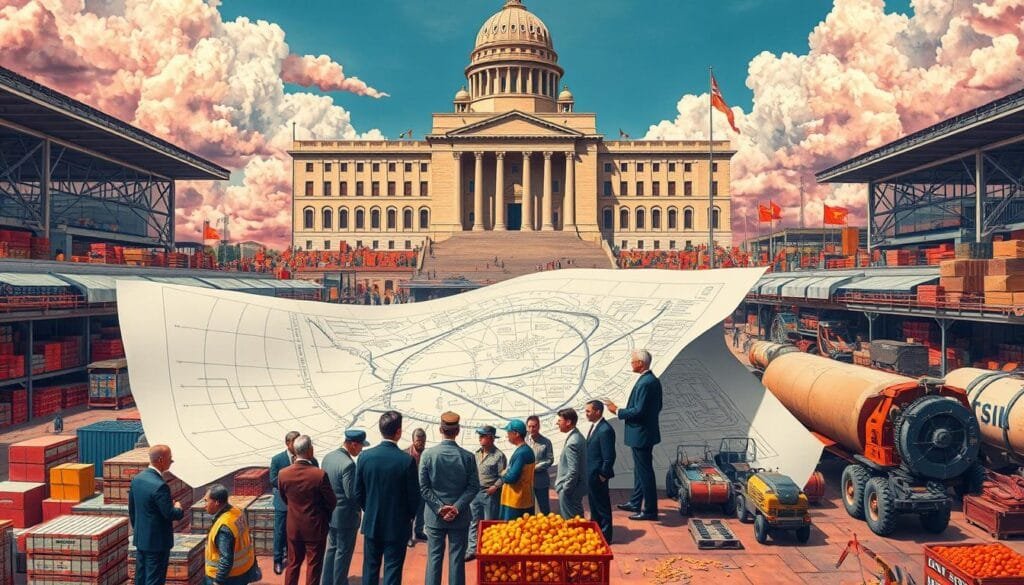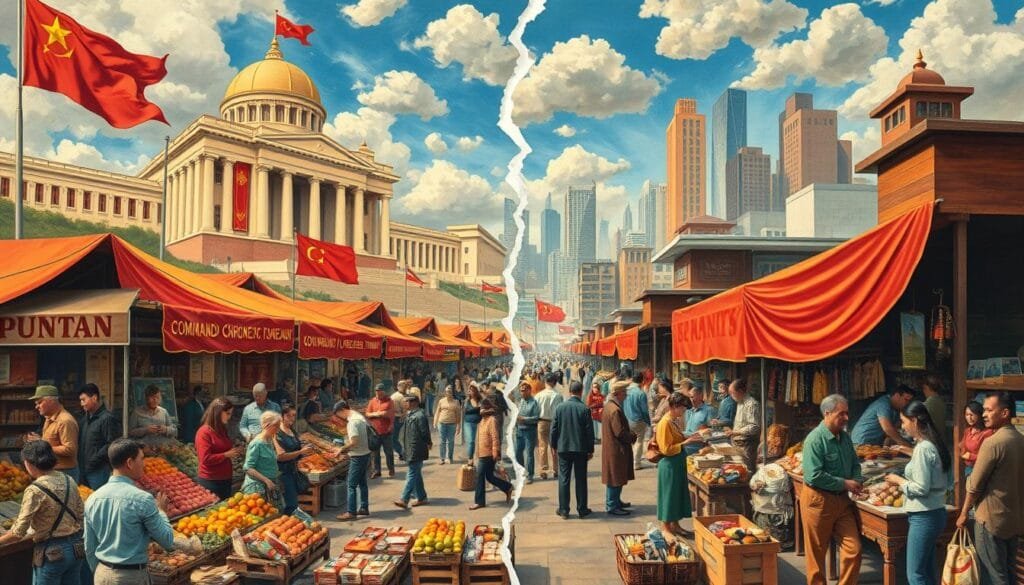Imagine a place where every big economic choice is decided by one powerful group. How does this system tackle the big questions of what to produce, how to use resources, and who gets what? These production questions get really interesting in a command economy. In such a system, the centralized government takes charge of major economic areas and guides all economic activities.
In places like North Korea and the old Soviet Union, command economies have controlled economic actions. This is very different from free-market economies. There, things like supply and demand decide economic results. By exploring how command economies work, we can understand what makes them unique. We can see their strengths and weaknesses compared to the capitalist model in the U.S.
Key Takeaways
- Command economies rely on centralized government control over big sectors.
- A central planning group makes economic decisions, not individual producers or consumers.
- These economies do not support private property, free market pricing, or consumer choice.
- Free market economies use voluntary exchanges and give a lot of economic freedom.
- The United States, although a market-based economy, also has significant government involvement in certain areas.
Understanding Command Economics
Command economies have a unique setup with centralized planning, socialism, and communism. They show us different ways economies can work, including their pros and cons.
Definition and Overview
A command economy is where the government controls everything. They decide what to make, how much, and who gets what. This is different from free-market systems. Here, what people want to buy and businesses drive the economy. In places like North Korea and Cuba, the government sets prices and what gets produced. They aim to prevent joblessness and keep prices stable.
Key Characteristics
Command economies are known for the government having a lot of power over jobs and resources. They try to put people’s needs above making money. This leads to fewer people without jobs and less gap between rich and poor. Yet, companies in these economies don’t have as much freedom as those in market economies.
Advantages and Disadvantages
Command economies are good at reducing unemployment and sharing resources fairly. State-controlled organizations are efficient during big projects. For example, despite many obstacles, Cuba’s system supports about 95% of its people through an unofficial economy. This shows how adaptable these systems can be.
But, there are issues with how well they work and come up with new ideas. Without competition, these economies don’t grow much and don’t meet people’s needs well. The government sets prices, not the market, leading to distorted views of what’s valuable. The Soviet Union faced big problems because of this, eventually leading to its economic failure.
Moving toward a market system can bring big improvements. China saw a 42% rise in farm output from 1978 to 1984 after it started using some market ideas. This hints at the good things that can happen when economies become more open and flexible.
For further details on the ups and downs of command economies, check out this detailed analysis.
- Governmental control over production and labor
- Focus on communal welfare and equitable distribution
- Efficiency in resource allocation for large projects
- Challenges in innovation and responsiveness to market demands
The Role of Government in a Command Economy
The role of government in a command economy is central. It involves government intervention in all economic areas. The state decides on the production, quantity, and price of goods and services. This control helps the government focus on national goals like more jobs and fair sharing of resources.

Government control also shapes education and career choices. The U.S. Bureau of Labor Statistics (BLS) noted the median pay for economists was $115,730 in 2023. Their jobs are growing by 6% through 2033, faster than other jobs. This shows the value of economic planners in such economies.
Economists often need a master’s degree or a doctorate. They work in various roles, such as consultants, financial analysts, and more. This highlights the broad impact of government decisions on careers in economic planning.
Here is a comparative table showcasing economic freedom rankings and the export percentage of domestic economic production in various countries from 2010 to 2013:
| Country | 2010 Exports (% GDP) | 2011 Exports (% GDP) | 2012 Exports (% GDP) | 2013 Exports (% GDP) |
|---|---|---|---|---|
| United States | 12.4% | 13.6% | 13.6% | 13.5% |
| Belgium | 76.2% | 81.4% | 82.2% | 82.8% |
| Canada | 29.1% | 30.7% | 30.0% | 30.1% |
| France | 26.0% | 27.8% | 28.1% | 28.3% |
| Mexico | 29.9% | 31.2% | 32.6% | 31.7% |
Looking at these stats, we see differences in how countries manage their economies. The government’s role in a command economy is very important. It affects a country’s economic success and the well-being of its people.
Command Economy vs Free-Market Economy
The debate between command and free-market economies is mainly about how they share resources and promote progress. Command economies focus on fairness and benefiting everyone. Free-market economies value competition and efficiency. Let’s look closer at their key traits.

Comparative Analysis
Command economies, seen in countries like Cuba and Venezuela, aim to give everyone equal chances by managing society’s needs. They sometimes limit personal freedom to reach common objectives. On the other hand, places like the United States champion competition and private ownership, though the government still plays a big role.
- Command Economies: Central leadership, planned outputs, little competition.
- Free-Market Economies: Spread-out choices, power to the consumers, focus on profits.
Impact on Innovation and Efficiency
Innovation often comes from competition and the need to use resources wisely. Milton Friedman mentioned that command economies might become authoritarian, stifling innovation. In World War II, the U.S. showed command economy traits, like set plans for production, which wasn’t great for new ideas in the long run.
“Rational prices cannot emerge without competition and private ownership within an economy.” – Ludwig von Mises
Resource Allocation
Command economies plan resources to benefit everyone. But, this can lead to waste because it doesn’t always match what people want. These economies often face issues changing when needed, causing problems in different areas. Meanwhile, free-market economies adapt quickly, driven by what customers want and the goal to make a profit.
| Aspect | Command Economy | Free-Market Economy |
|---|---|---|
| Economic Freedom | Restricted | High |
| Innovation in Economics | Limited by central control | Boosted by competition |
| Efficiency in Resource Allocation | Often not efficient | Improved by market actions |
| Consumer Influence | Little | Strong |
Both command and free-market economies have different ways of reaching growth and stability. Their approaches to spreading innovation and handling resources show clear differences. Each aims for prosperity, but they go about it in unique ways.
How Do Command Economics Answer the 3 Questions How?
Command economies focus on centralized control. This affects everything from what is made to how resources are given out. By looking at how they solve three key questions, we learn more about their workings and effects.
How is Production Determined?
The government decides what to produce and how much in a command economy. They make these choices based on what they think will help the country reach its goals, not on what people want to buy. For example, in Belarus, the government has a say in about 70% of businesses. They set goals for these businesses to meet.
In China, they use five-year plans. These plans set economic goals to guide what the country makes.

How are Resources Allocated?
In command economies, the government also decides where to use resources. They often focus on areas they think are important. For instance, North Korea gives resources to industries based on what the government thinks is best. This doesn’t always lead to good results. Iran has seen problems because the government controls too much of how resources are used.
| Country | Public Ownership Percentage | Key Sectors |
|---|---|---|
| Belarus | 70% | Businesses |
| Libya | Majority | Oil and Gas |
| North Korea | High | Industrial |
How are Goods and Services Distributed?
The way things are shared out in command economies is planned. This is different from market economies, where supply and demand rule. In Cuba, for example, the government strictly controls distribution. This helps make sure people get what they need. But it also means there’s less choice.
North Korea shows how this system can lead to problems. Industries there are often less productive than in countries with market economies.
Production in Command Economies
In command economies, the central planning by the government decides economic output in many areas. Countries like North Korea and Cuba use such plans. They aim to meet goals like high employment and industrial growth by directing resources. However, this approach may not always get what people need or want right.
Central Planning and Output
Command economies target around 4-5% growth yearly through central planning. But they often miss these goals due to inefficiencies and not using resources well. Since the government controls almost all production, this greatly affects the economy. When it comes to income, these economies often show less inequality, with lower Gini scores, than market economies like the USA and Japan.
Efficiency and Innovation
Without competition, command economies struggle with efficiency and innovation. Their innovation rate is lower compared to market economies. Price controls can also make up to 30% of essential goods hard to find. Sometimes, prices on the black market jump up to 20%, even when official inflation is kept under 2%. And central planning can make things up to 30% less efficient, with growth in how much each worker produces staying low.
| Indicator | Command Economies | Market Economies |
|---|---|---|
| Innovation Rate | 1.5-2% | 5-7% |
| Labor Productivity Growth Rate | 2% | 3.5-5% |
| Gini Coefficient | < 0.30 | > 0.40 |
| Official Inflation Rate | < 2% | Varies |
| Black-Market Inflation Rate | ~20% | N/A |
Resource Allocation in Command Economies
In command economies, the government decides how resources are used to meet big goals. It uses state-controlled resources to try and make things fair in money matters and at work.
Government Control
In the past, places like the Soviet Union had all economic choices made by the state. This included what would be produced, how materials were shared out, and the levels of goods to be made. Yet, this strict way of planning often led to problems. For example, in 1985, Mikhail Gorbachev tried to fix these issues with reforms.
Economic Equality
The main goal in these economies is to make sure everyone has the same chance by controlling resources. This way, they hoped to avoid the gaps between rich and poor seen in free markets. But, without personal rewards, people were less driven to invent or work hard.
Labor Distribution
Command economies also decide how work is split up, using a big plan. Planners decide how many workers different jobs need, focusing on what the country needs most. This might mean more people working in factories or defense, even if it causes shortages in everyday items and makes people unhappy.
| Economic System | Resource Allocation | Productivity | Innovation |
|---|---|---|---|
| Command Economy | State-Controlled | 30-50% Lower | 1-2% Annually |
| Market Economy | Market-Based | Higher | 5-7% Annually |
| Mixed Economy | Combined Control | Varies | Varies |
Distribution of Goods and Services in Command Economies
In command economies, central control dominates. It focuses on meeting basic needs and fairness. Governments use detailed economic planning for managing resources and goods distribution.
But, focusing on central planning can miss what people actually want. Countries like North Korea, Cuba, and the former Soviet Union have faced product shortages. Ludwig von Mises believed centralized control messes with prices and calculations, leading to resources being poorly used.
These economies aim to get rid of joblessness by assigning work. The Soviet Union tried fixing production issues with the New Economic Plan in 1921. Yet, mismatches in production and demand often cause wastefulness and inefficiency.
Now, let’s dive into some data that shows command economies’ varied outcomes:
| Country | Main Characteristics | Impact on Goods Distribution | Service Allocation |
|---|---|---|---|
| Cuba | High focuses on fairness, little private ownership | Meets basic needs, ignores variety | Centralized, puts public services first |
| North Korea | Complete control, no market effect | Regular shortages, few consumer products | Driven by the state, targets key areas |
| Former Soviet Union | Broad central planning, public owns everything | Flawed economic planning, not effective | Set service sectors, often not working well |
Central control in command economies leads to mixed results. It does ensure everyone has a basic standard of living. But it struggles with changing market demands and what people need. This shows the core flaws of such systems.
Conclusion
As we finish looking at command economics, we see it has pros and cons. This system looks to meet everyone’s basic needs. It tries for low unemployment and fairness in wealth. But, this can sacrifice efficiency and new ideas, which matter in a fast-changing world.
Command economies control key resources, like gold or oil, but struggle with quick changes. Having all power in one place makes them riskier in crises. It’s vital to think about what to produce, using resources wisely and meeting what people need and want.
Mixed economic systems mix government rules with free market actions. This blend is common in developed countries. It tries to take the best parts of both command and market economies. Finding the right mix is a big challenge but is crucial as the world evolves.
FAQ
What defines a command economy?
In a command economy, the government controls production and resources. It decides what and how things are made, and the pricing.
What are the key characteristics of a command economy?
Centralized planning and government control mark a command economy. It focuses on community welfare over individual profits. This is opposite to the consumer-driven, private enterprise system found in free markets.
What are the advantages of a command economy?
Command economies aim to reduce unemployment and promote equality. They focus on fair resource distribution and meeting everyone’s basic needs.
What are the disadvantages of a command economy?
Drawbacks include less efficiency and innovation. Competition is limited, leading to potential mismanagement and not meeting consumer desires. The lack of profit motive may decrease productivity too.
How does government intervention play a role in a command economy?
The government heavily controls the economy, deciding on production, resource use, and prices. It aims to distribute resources for the common good.
What is the difference between a command economy and a free-market economy?
A main difference is who controls the economy. Command economies use central plans to ensure equality and security. Free markets rely on consumer demand and competition for efficiency and innovation.
How is production determined in a command economy?
The government sets output for sectors with central planning. This might cause too much or not enough production due to planning errors.
How are resources allocated in a command economy?
The government allocates resources to reach social and economic goals, like equality. This strict control can be inefficient and ignore people’s choices.
How are goods and services distributed in a command economy?
Distribution is planned centrally to meet specific objectives, like reducing inequality. This limits market flexibility and consumer choice.
What is central planning’s role in determining economic output?
Central planning sets production targets to allocate resources strategically. Lack of competition, however, may cause inefficiency and less innovation.
How does labor distribution work in a command economy?
The government decides labor distribution based on its goals. This aims for equality but may not align with workers’ desires, affecting productivity.
What are the social benefits of a command economy?
Social benefits include job security, meeting basic needs, and promoting equality. These come at a cost to efficiency and innovation.
